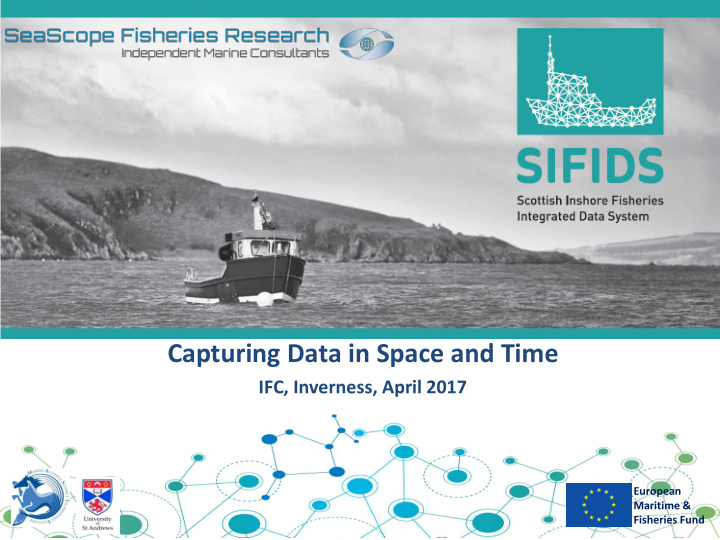



Capturing Data in Space and Time IFC, Inverness, April 2017 European Maritime & Fisheries Fund
• Me : Richard Ayers • Working in fisheries for 30 years, now at SeaScope Fisheries. • Worked in the pot fisheries from Bridlington and around the Channel Coast
• Sub-contractors to the SIFIDS project. • Heavily involved in observer schemes and electronic monitoring and research for the last twenty years. • Core team have over 80 years combined experience working in a wide range of fisheries . • Working on 4 packages within the SIFIDS project.
Work Package 2A (and 2B) • Feasibility/Pilot study, can we collect high resolution data remotely and automatically. • Without : » Impacting the way you work » Overloading vessels with expensive ‘soft’ equipment • With : » Protecting your data » Your help
What are the benefits right now? • Improved data = improved science • Improved science = improved advice • Improved advice = better management • Better management = secure, sustainable fisheries
What are the benefits in the future ? • Automatic data collection means less manual reporting • High resolution data could allow more localised management • Traceability, eventual consumers could know exactly where and when the lobster they are buying was caught, leading to better prices at first sale Page 1…..
What are the benefits in the future ? • Verified high resolution data showing exactly where the important grounds, for each vessel, are. – When discussing marine planning and stock management, you and Marine Scotland have the evidence to support your fisheries. • Analyse your own data, find new patterns and become more effective and efficient. • Maximise financial returns for time at sea
What data are we collecting • Work package 2A is focussed on getting high precision position (GPS) data at up to once per second. • Connecting that position and time data to other data (from the other work packages). • Getting all that data back ashore and available. • Without anyone having to do anything.
Its not just another EM system • Designed for small vessels • Designed for scientific data collection • Multiple sensor inputs • Near real time data transfer • This is the opportunity for you to get involved, it could collect data you can make use of.
Now 2B fits into the picture • Work package 2B is focussed on getting effort and catch data to connect to the GPS data. – Where and when each string was shot and hauled? – How many pots were in the string? – What did the string catch? • We have ideas on how to achieve this, but we are going to need your help to find the best way(s)
The WP2A kit • Small. • Low power. • 2 GPS loggers, data store, data communications box, some aerials and cables. • Designed to survive. • 3G/4G/Wi-Fi data transfer. • Installation takes a few hours. • Engineer on board for 1 st trip or 2.
The main kit, in pictures
Get involved • How do you think we could do it? • What could the system do for you that we haven’t thought of? • Easy ways to sex crabs and lobsters quickly ?
Sexing crabs the scientific way Male Female ??
What happens next • Facilitators are recruiting vessels to join the project, we need 15 vessels to trial the logging equipment. • Project team at St Andrews are assessing our proposals, your input is welcomed. • Field trials Spring 2018.
Questions, Comments, Ideas, Thoughts ? • Ask me now • Find me later • Talk to the facilitators • Email any of the SeaScope team • richard@seascopefisheries.co.uk • grant@seascopefisheries.co.uk • guy@seascopefisheries.co.uk • Thank you for listening
Recommend
More recommend